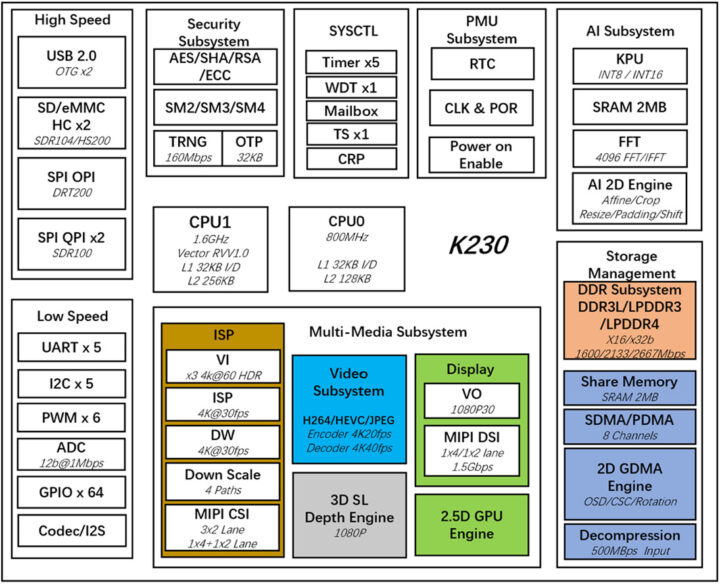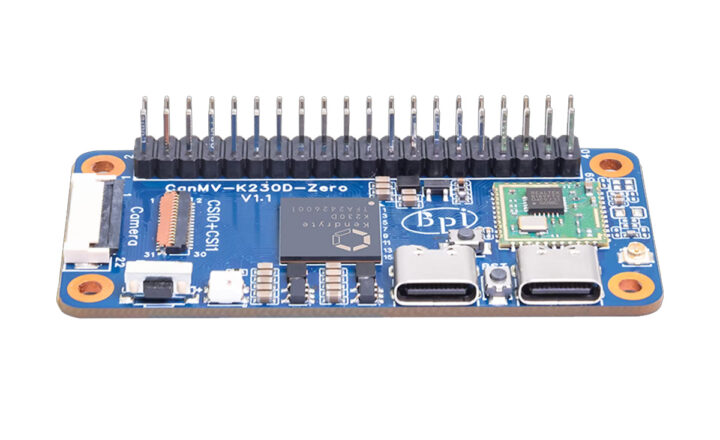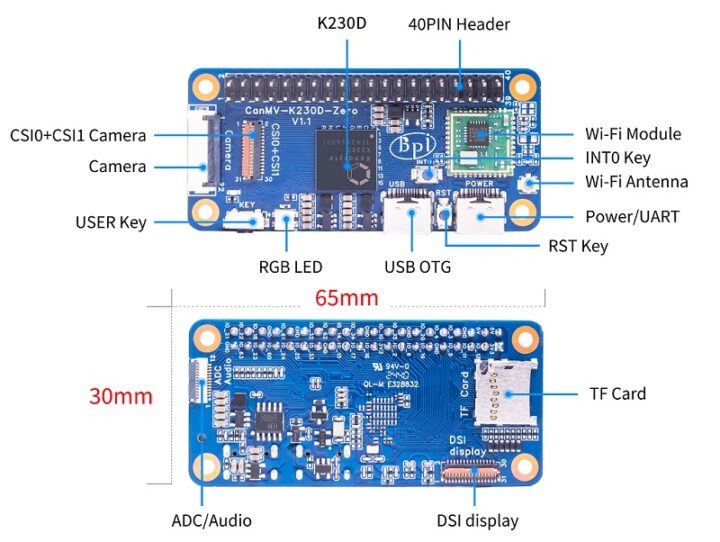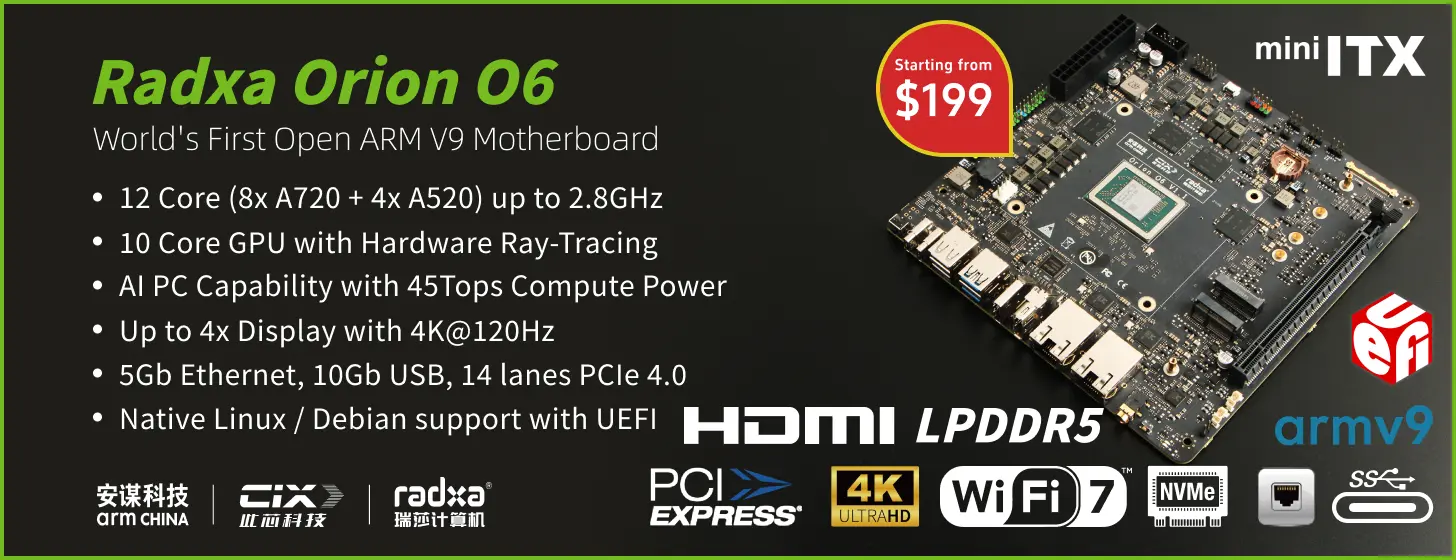Banana Pi BPI-CanMV-K230D-Zero Specifications
- SoC – Kendryte K230D
- CPU
- CPU1 – 64-bit RISC-V processor @ 1.6GHz with RVV 1.0 support
- CPU2 – 64-bit RISC-V processor @ 800MHz
- AI accelerator
- Third-generation KPU with support for INT8 and INT16
- Typical network performance: Resnet 50 ≥ 85fps @ INT8; Mobilenet_v2 ≥ 670fps @ INT8; YoloV5S ≥ 38fps @INT8;
- DPU – Built-in 3D structured light depth engine, maximum up to 1920×1080
- VPU – Video encoding/decoding for H.264/H.265 hardware encoder/decoder
- CPU
- System Memory – 128MB LPDDR4 @ 2666Mbps
- Storage – MicroSD card slot
- Display – MIPI DSI interface up to 1080p
- Audio
- Onboard microphone (But nowhere to be found… wrong specifications?)
- ADC/Audio FPC connector
- Camera – 2-lane MIPI-CSI connector, 4-lane MIPI-CSI connector; resolution up to 4K
- Networking – Supports 2.4GHz WiFi
- USB – USB 2.0 OTG Type-C port
- Debugging – USB Type-C port for serial console (and power)
- Expansion – 40-pin GPIO header which supports I2C/UART/I2S/SPI/PWM/ADC/JTAG
- Misc – Function button; Reset button; RGB LED
- Power Supply – 5V via USB-C port
- Dimensions – 65 x 30 mm (Raspberry Pi Zero form factor)

In terms of software, Banana Pi points to the CanMV GitHub repository, which contains resources for the K230 SDK, on top of that they mention that the KPU supports various neural networks including ResNet50, MobileNet_V2, and YOLOv5 which makes this device suitable for image and video processing, audio analysis, and general AI work.
Previously Banana Pi released Banana Pi BPI-M4 Zero which also has an identical form factor but is built around an Allwinner H618 SoC, the main difference between the two is that the BPI-M4 Zero is a general-purpose SBC with various multimedia and connectivity options, making it a versatile choice for DIY projects and general computing tasks. The BPI-CanMV-K230D-Zero on the other hand is optimized for AI and machine learning, with specialized hardware for neural network processing and a focus on IoT and AI-driven applications. We have also written about various SBCs and development boards from Banana Pi including Banana Pi BPI-M1S, the Banana Pi BPI-CM5 Pro, the Banana Pi BPI-WiFi6, and others.
The Banana Pi BPI-CanMV-K230D-Zero can be purchased from the Banana Pi AliExpress store for $28.90 and on Amazon for $39.90. Some additional information about the board can be found on the Wiki page.
Debashis Das is a technical content writer and embedded engineer with over five years of experience in the industry. With expertise in Embedded C, PCB Design, and SEO optimization, he effectively blends difficult technical topics with clear communication
Support CNX Software! Donate via cryptocurrencies, become a Patron on Patreon, or purchase goods on Amazon or Aliexpress







So: what do you run on this? Linux? Micropython? Unclear to me …
MicroPython based on the images provided on the GitHub repo.
It might be a fork on OpenMV called CanMV, but it’s not 100% clear.
Linux SDK is now linked in their website: https://gitee.com/kendryte/k230_linux_sdk
I am wondering what is that WCH chip on the bottom side of PCB. On product page you can see higher res photos, and if my eyes got it right, this is CH312K IC. What is this? Google does not know it neither. I checked briefly the board schematics and I didnt see it there.
(a bit late to reply but maybe it helps someone)
The photos indeed show a CH312K (which I don’t think it exists), but the schematic and the board (at least the one I have) use the CH342K.
It is a USB to dual UART bridge, connected to the UART0 and UART2 ports and the USB port on the corner (the other USB port is connected directly to the SoC and can be used for firmware burning and as Host/Device, but it cannot power the board).
UART0 is used by the BootROM and the small core during boot (U-Boot). After that, it seems that it depends on the SDK (Linux+RTOS or RTOS only), I use RTOS only and the big core also prints to UART0 while running RT-Thread. In dual-core mode, each core uses one port, probably the big core uses UART2 but I can’t remember exactly.